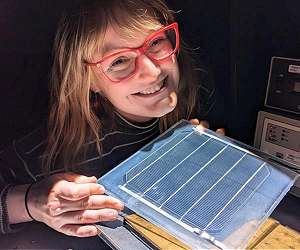Perovskite solar cells have drawn a significant amount of research attention as a promising alternative to conventional silicon-based solar cells, due to their efficiency in converting sunlight into electricity. Perovskite solar cells are a hybrid of organic and inorganic materials and consist of a light-harvesting layer and a charge-transporting layer.
However, stability issues have hindered the commercialization and widespread use of PSCs, and achieving operational stability has become a rallying cry among scientists in the field. Now, researchers led by Michael Gratzel at EPFL and Xiong Li at the Michael Gratzel Center for Mesoscopic Solar Cells in Wuhan (China) have developed a technique that addresses stability concerns and increases the efficiency of PSCs.
The researchers introduced a phosphonic acid-functionalized fullerene derivative into the charge-transporting layer of the PSC as a “grain boundary modulator”, which helps strengthen the perovskite crystal structure and increases the PSC’s resistance to environmental stressors like heat and moisture.
The team also developed a redox-active radical polymer called poly(oxoammonium salt) that effectively “p-dopes” the hole-transporting material – a crucial component of the PSCs. The polymer, acting as a “p-dopant,” improves the conductivity and stability of the hole-transporting material, a crucial component of the cells.
The process of “p-doping” involves introducing mobile charge electronic charge carriers into the material to improve its conductivity and stability, and in this case mitigated the diffusion of lithium ions, a major problem that contributes to the operational instability of PSCs.
With the new technique, the scientists achieved power conversion efficiencies of 23.5% for small PSCs and 21.4% for larger “minimodules.” These efficiencies are comparable to traditional solar cells, with the added advantage of an improved stability for PSCs. The solar cells retained 95.5% of their initial efficiency after more than 3200 hours of continuous exposure to simulated sunlight maintaining the temperature at 75 C over the whole period, a significant improvement over previous PSC designs.
The new approach can revolutionize the use of PSCs, making them accessible for use on a larger scale. The researchers believe that their technique could be easily scaled up for industrial production and could potentially be used to create stable, high-efficiency PSC modules.
Research Report:Radical polymeric p-doping and grain modulation for stable, efficient perovskite solar modules.
Related Links
Swiss Federal Institute of Technology Lausanne
All About Solar Energy at SolarDaily.com
|
We need your help. The SpaceDaily news network continues to grow but revenues have never been harder to maintain. With the rise of Ad Blockers, and Facebook – our traditional revenue sources via quality network advertising continues to decline. And unlike so many other news sites, we don’t have a paywall – with those annoying usernames and passwords. Our news coverage takes time and effort to publish 365 days a year. If you find our news sites informative and useful then please consider becoming a regular supporter or for now make a one off contribution. |
||
|
SpaceDaily Contributor $5 Billed Once credit card or paypal |
SpaceDaily Monthly Supporter $5 Billed Monthly paypal only |
|

![]()
Harnessing solar energy: new method improves readings of double-sided panels
Ottawa, Canada (SPX) Jan 19, 2023
A leading laboratory in photonics and renewable energy at the University of Ottawa has developed a new method for measuring the solar energy produced by bifacial solar panels, the double-sided solar technology which is expected to meet increased global energy demands moving forward.
Published in the journal Joule, this study from the SUNLAB team in the Faculties of Engineering and Science proposes a characterization method that will improve the measurement of bifacial panels indoors by considering … read more
